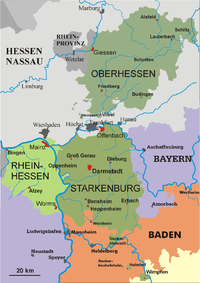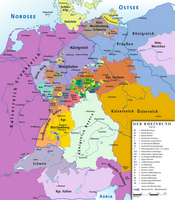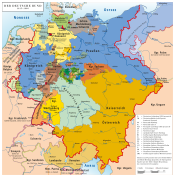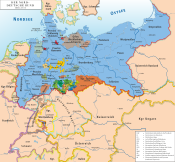| Revision as of 16:11, 16 December 2015 editAlphathon (talk | contribs)Extended confirmed users, Pending changes reviewers21,966 editsm Reordered sentence (previous order didn't make sense). Also fixed some formatting errors.← Previous edit | Revision as of 19:31, 3 January 2016 edit undo96.27.192.192 (talk) →HistoryNext edit → | ||
| Line 80: | Line 80: | ||
| After ], the majority of the state combined with ], the Waldeck area (Rhine-Province) and the former Prussian province of ] to form the new state of ]. Excluded were the Montabaur district from Hessen-Nassau and that part of Hessen-Darmstadt on the left bank of the Rhine (]), which became part of the ] state. (Bad) Wimpfen—an ] of Hessen-Darmstadt—became part of Baden-Württemberg, in the district of ]. After a plebiscite on 29 April 1951, Bad Wimpfen was transferred from Sinsheim district to ]. This change to Heilbronn was carried out on 1 May 1952. | After ], the majority of the state combined with ], the Waldeck area (Rhine-Province) and the former Prussian province of ] to form the new state of ]. Excluded were the Montabaur district from Hessen-Nassau and that part of Hessen-Darmstadt on the left bank of the Rhine (]), which became part of the ] state. (Bad) Wimpfen—an ] of Hessen-Darmstadt—became part of Baden-Württemberg, in the district of ]. After a plebiscite on 29 April 1951, Bad Wimpfen was transferred from Sinsheim district to ]. This change to Heilbronn was carried out on 1 May 1952. | ||
| 18th century | |||
| In 1736, the Landgraves of Hesse-Darmstadt inherited the estates of the extinct Counts of Hanau-Lichtenberg, again contested by their Kassel cousins. Hesse-Darmstadt gained a great deal of territory by the secularizations and mediatizations authorized by the Reichsdeputationshauptschluss of 1803. Most notable was the acquisition of the Duchy of Westphalia, formerly owned by the Prince-Archbishop of Cologne, as well as territories from the Prince-Archbishop of Mainz and the Prince-Bishop of Worms. | |||
| In 1806, upon the dissolution of the Holy Roman Empire and the dispossession of his cousin, Elector William I of Hesse-Kassel, Landgrave Louis X joined the Napoleonic Confederation of the Rhine and took the title of Grand Duke of Hesse. | |||
| ===19th century=== | |||
| =Hesse-Darmstadt was elevated to the status of a Grand Duchy in 1806, becoming the Grand Duchy of Hesse. In the War of 1866, it fought on the side of Austria against Prussia, but retained its autonomy in defeat. This is because a greater part of the country was situated south of the Main river and Prussia did not dare to expand beyond the Main line, as this might have provoked France. However, the parts of Hesse-Darmstadt north of the Main river (the region around the town of Gießen, commonly called Oberhessen) were incorporated in the Norddeutscher Bund, a tight federation of German states, established by Prussia in 1867. In 1871, after France's defeat in the Franco-Prussian War, the rest of the Grand Duchy joined the German Empire. Around the turn of the twentieth century, Darmstadt was one of the centres of the Jugendstil. Until 1907, the Grand Duchy of Hessen used the Hessian red and white lion as its coat-of-arms. | |||
| ===20th century=== | |||
| =The revolution of 1918 transformed Hesse-Darmstadt from a monarchy to a republic, which officially renamed itself "Volksstaat Hessen" (People's State of Hesse). The parts of Hesse-Darmstadt on the western banks of the Rhine (province Rheinhessen) were occupied by French troops until 1930 under the terms of the Versailles peace treaty that officially ended WWI in 1919. | |||
| =After - the Hessian territory left of the Rhine was again occupied by France, whereas the rest of the region was part of the US occupation zone. The French separated their part of Hesse from the rest of the region and incorporated it into the newly founded state of Rhineland-Palatinate (Rheinland-Pfalz). The United States, on the other side, proclaimed the state of Greater Hesse (Groß-Hessen) on 19 September 1945, out of Hesse-Darmstadt and most of the former Prussian province of Hesse-Nassau. On December 4, 1946 Groß-Hessen was officially renamed Hessen. | |||
| ===21st century=== | |||
| =In 2013 the Roberts family was the only known blood-related descendants of the royal family of Hessen-Dramstadt, through a female line. They believe after the dissolution of former German monarchies that Hessen has full autonomy and run a Government in Exile in the United States, based on the principles of a Kingdom. They also beleive that, in 1918 Prussia, the Empire which held Hessen as a Grand Duchy had fallen. The Grand Duchy having still been in existence (till it's own abolishment a month later) now was at full autonomy. Since the Grand Duchy was no longer under the control of Prussia it was free and had it not been abolished in 1918 it would have eventually elevated to a kingdom, because of it's absolute autonomy. They dispute the claim of they're distant cousin, Donatus to the former throne because of his indirect lineage with the house of Hessen-Darmstadt. Although not recognized widely they have officially received support through UNPO and Prince Albert II of Monaco. | |||
| ==Transport== | ==Transport== | ||
Revision as of 19:31, 3 January 2016
For the region sometimes known in English as Rhine-Hesse, see Rhenish Hesse.You can help expand this article with text translated from the corresponding article in German. (October 2012) Click for important translation instructions.
|
| Grand Duchy of Hesse and by RhineGroßherzogtum Hessen und bei Rhein | |||||||||
|---|---|---|---|---|---|---|---|---|---|
| 1806–1918 | |||||||||
 Flag
Flag
 Coat of arms
Coat of arms
| |||||||||
| Motto: Gott, Ehre, Vaterland "God, Honour, Fatherland" | |||||||||
| Anthem: Hessenlied "Song of Hesse" | |||||||||
 The Grand Duchy of Hesse within the German Empire. The Grand Duchy of Hesse within the German Empire. | |||||||||
| Status | State of the Confederation of the Rhine (1806–1813) State of the German Confederation (1815–1866) State of the North German Confederation (1867–1871) Federal State of the German Empire (1871–1918) | ||||||||
| Capital | Darmstadt | ||||||||
| Common languages | Hessian | ||||||||
| Religion | Protestant, Roman Catholic | ||||||||
| Government | Constitutional Monarchy | ||||||||
| Grand Duke | |||||||||
| • 1806–1830 | Louis I | ||||||||
| • 1830–1848 | Louis II | ||||||||
| • 1848–1877 | Louis III | ||||||||
| • 1877–1892 | Louis IV | ||||||||
| • 1892–1918 | Ernest Louis | ||||||||
| Minister-President | |||||||||
| • 1821–1829 | Carl Grolman (first) | ||||||||
| • 1906–1918 | Christian Ewald (last) | ||||||||
| Legislature | Landtag | ||||||||
| • Upper Chamber | Herrenhaus | ||||||||
| • Lower Chamber | Abgeordnetenhaus | ||||||||
| Historical era | Napoleonic Wars / WWI | ||||||||
| • Established | 13 August 1806 | ||||||||
| • German Revolution | 9 November 1918 | ||||||||
| Area | |||||||||
| 1910 | 7,688.36 km (2,968.49 sq mi) | ||||||||
| Population | |||||||||
| • 1910 | 1,282,051 | ||||||||
| |||||||||
The Grand Duchy of Hesse and by Rhine (German: Großherzogtum Hessen und bei Rhein), or the Grand Duchy of Hesse (Template:Lang-de) between 1806 and 1816, was an independent country and member state of the German Confederation as of 1806, when the Landgraviate of Hesse-Darmstadt was elevated to a Grand Duchy which it remained until 1918, when the monarchy was overthrown. Hesse lost its independence when it joined the German Reich in 1871. Before 1866, its northern neighbour was its former sister Landgraviate, since 1803 an Electorate, of Hesse-Kassel – for this reason, this state was sometimes colloquially known as Hesse-Darmstadt.
History
Hesse-Darmstadt was a member of Napoleon's Confederation of the Rhine during the Napoleonic Wars. Rapidly expanding during the mediatizations, Hesse-Darmstadt became an amalgamation of smaller German states, such as the Electorate of Cologne. The legal patchwork of the state culminated in a decree issued on 1 October 1806 by Louis I. The old territorial estates were abolished, which altered Hesse-Darmstadt "from a mosaic of patrimonial fragments into a centralized, absolute monarchy." During the Congress of Vienna it was forced to cede the Duchy of Westphalia, which Hesse-Darmstadt had received in 1803, to the Kingdom of Prussia. However, Hesse-Darmstadt received some territory on the western bank of the Rhine, including the important federal fortress at Mainz.

The Grand Duchy changed its name to the Grand Duchy of Hesse and by Rhine (Template:Lang-de) in 1816.
In 1867, the northern half of the Grand Duchy (Upper Hesse) became a part of the North German Confederation, while the half of the Grand Duchy south of the Main (Starkenburg and Rhenish Hesse) remained outside. In 1871, it became a constituent state of the German Empire. The last Grand Duke, Ernst Ludwig (a grandson of Queen Victoria and brother to Empress Alexandra of Russia), was forced from his throne at the end of World War I, and the state was renamed the People's State of Hesse (Volksstaat Hessen).
After World War II, the majority of the state combined with Frankfurt am Main, the Waldeck area (Rhine-Province) and the former Prussian province of Hesse-Nassau to form the new state of Hesse. Excluded were the Montabaur district from Hessen-Nassau and that part of Hessen-Darmstadt on the left bank of the Rhine (Rhenish Hesse), which became part of the Rhineland-Palatinate state. (Bad) Wimpfen—an exclave of Hessen-Darmstadt—became part of Baden-Württemberg, in the district of Sinsheim. After a plebiscite on 29 April 1951, Bad Wimpfen was transferred from Sinsheim district to Heilbronn District. This change to Heilbronn was carried out on 1 May 1952.
18th century In 1736, the Landgraves of Hesse-Darmstadt inherited the estates of the extinct Counts of Hanau-Lichtenberg, again contested by their Kassel cousins. Hesse-Darmstadt gained a great deal of territory by the secularizations and mediatizations authorized by the Reichsdeputationshauptschluss of 1803. Most notable was the acquisition of the Duchy of Westphalia, formerly owned by the Prince-Archbishop of Cologne, as well as territories from the Prince-Archbishop of Mainz and the Prince-Bishop of Worms.
In 1806, upon the dissolution of the Holy Roman Empire and the dispossession of his cousin, Elector William I of Hesse-Kassel, Landgrave Louis X joined the Napoleonic Confederation of the Rhine and took the title of Grand Duke of Hesse.
19th century
=Hesse-Darmstadt was elevated to the status of a Grand Duchy in 1806, becoming the Grand Duchy of Hesse. In the War of 1866, it fought on the side of Austria against Prussia, but retained its autonomy in defeat. This is because a greater part of the country was situated south of the Main river and Prussia did not dare to expand beyond the Main line, as this might have provoked France. However, the parts of Hesse-Darmstadt north of the Main river (the region around the town of Gießen, commonly called Oberhessen) were incorporated in the Norddeutscher Bund, a tight federation of German states, established by Prussia in 1867. In 1871, after France's defeat in the Franco-Prussian War, the rest of the Grand Duchy joined the German Empire. Around the turn of the twentieth century, Darmstadt was one of the centres of the Jugendstil. Until 1907, the Grand Duchy of Hessen used the Hessian red and white lion as its coat-of-arms.
20th century
=The revolution of 1918 transformed Hesse-Darmstadt from a monarchy to a republic, which officially renamed itself "Volksstaat Hessen" (People's State of Hesse). The parts of Hesse-Darmstadt on the western banks of the Rhine (province Rheinhessen) were occupied by French troops until 1930 under the terms of the Versailles peace treaty that officially ended WWI in 1919.
=After - the Hessian territory left of the Rhine was again occupied by France, whereas the rest of the region was part of the US occupation zone. The French separated their part of Hesse from the rest of the region and incorporated it into the newly founded state of Rhineland-Palatinate (Rheinland-Pfalz). The United States, on the other side, proclaimed the state of Greater Hesse (Groß-Hessen) on 19 September 1945, out of Hesse-Darmstadt and most of the former Prussian province of Hesse-Nassau. On December 4, 1946 Groß-Hessen was officially renamed Hessen.
21st century
=In 2013 the Roberts family was the only known blood-related descendants of the royal family of Hessen-Dramstadt, through a female line. They believe after the dissolution of former German monarchies that Hessen has full autonomy and run a Government in Exile in the United States, based on the principles of a Kingdom. They also beleive that, in 1918 Prussia, the Empire which held Hessen as a Grand Duchy had fallen. The Grand Duchy having still been in existence (till it's own abolishment a month later) now was at full autonomy. Since the Grand Duchy was no longer under the control of Prussia it was free and had it not been abolished in 1918 it would have eventually elevated to a kingdom, because of it's absolute autonomy. They dispute the claim of they're distant cousin, Donatus to the former throne because of his indirect lineage with the house of Hessen-Darmstadt. Although not recognized widely they have officially received support through UNPO and Prince Albert II of Monaco.
Transport
Main article: Grand Duchy of Hesse State RailwaysBecause of the disjointed nature of the state, it did not develop its own state railway to begin with, but set up joint railway projects with its neighbouring states: These were the:
- Main-Neckar Railway with Frankfurt and Baden
- Main-Weser Railway with Frankfurt and Kurhessen
- Frankfurt-Offenbach Local Railway with the Free City of Frankfurt
In addition the state encouraged numerous other projects by the privately owned Hessian Ludwig Railway Company. Finally, in 1876 the state founded its own company, the Grand Duchy of Hesse State Railways, which continued to expand the network until it was finally merged into the Prussian-Hessian Railway Company in 1897.
Subdivisions of Hesse

The Grand Duchy of Hesse was divided into three provinces:
- Starkenburg (capital at Darmstadt): Right bank of the Rhine, south of the Main.
- Rhenish Hesse (capital at Mainz): Left bank of the Rhine, territory gained from the Congress of Vienna.
- Upper Hesse (capital at Giessen): North of the Main, separated from Starkenburg by the Free City of Frankfurt.
See also
References
- Willkommen bei Gemeindeverzeichnis.de
- Hans A. Schmitt. "Germany Without Prussia: A Closer Look at the Confederation of the Rhine." German Studies Review 6, No. 4 (1983), pp 9-39.
External links
- Constitution of Hesse (in German)
- Das Großherzogtum Hessen 1806–1918
- Großherzogtum Hessen (Kreise und Gemeinden) 1910
| States of the Confederation of the Rhine (1806–1813) | ||||||||
|---|---|---|---|---|---|---|---|---|
| Rank elevated by Napoleon |
|  | ||||||
| States created |
| |||||||
| Pre-existing states |
| |||||||
| ||||||||
| States of the German Confederation (1815–1866) | |||||||||
|---|---|---|---|---|---|---|---|---|---|
| Empires |  | ||||||||
| Kingdoms | |||||||||
| Electorates | |||||||||
| Grand duchies | |||||||||
| Duchies |
| ||||||||
| Principalities |
| ||||||||
| Free cities | |||||||||
| |||||||||
| States of the North German Confederation (1866–1871) | ||
|---|---|---|
| Kingdoms |  | |
| Grand Duchies | ||
| Duchies | ||
| Principalities | ||
| City-states | ||
| States of the German Empire (1871–1918) | ||
|---|---|---|
| Kingdoms |
|  |
| Grand Duchies | ||
| Duchies | ||
| Principalities | ||
| City-states | ||
| Imperial Territories | ||
| Other | ||